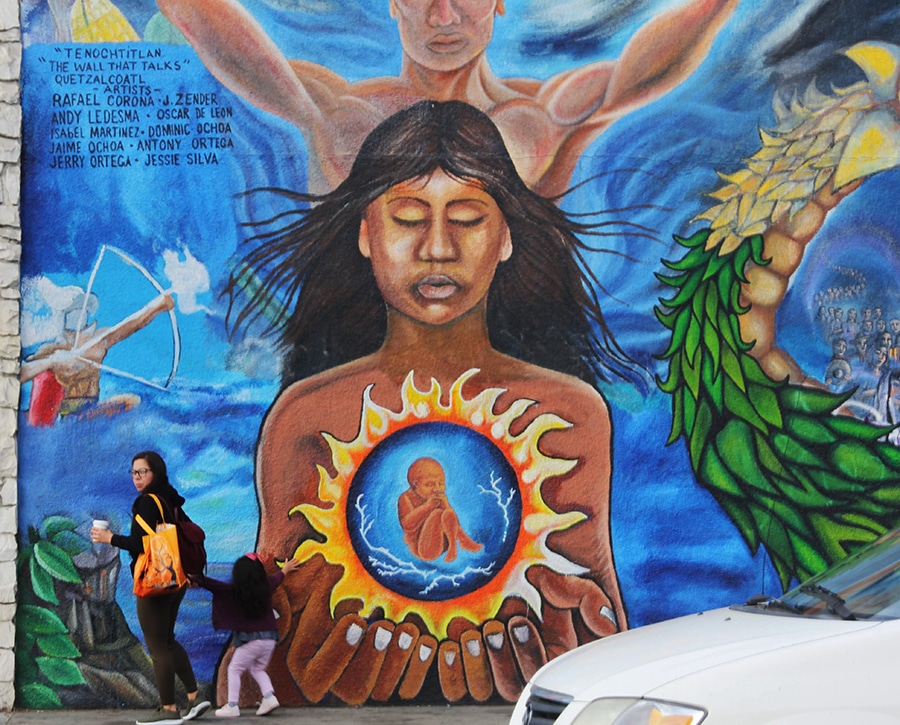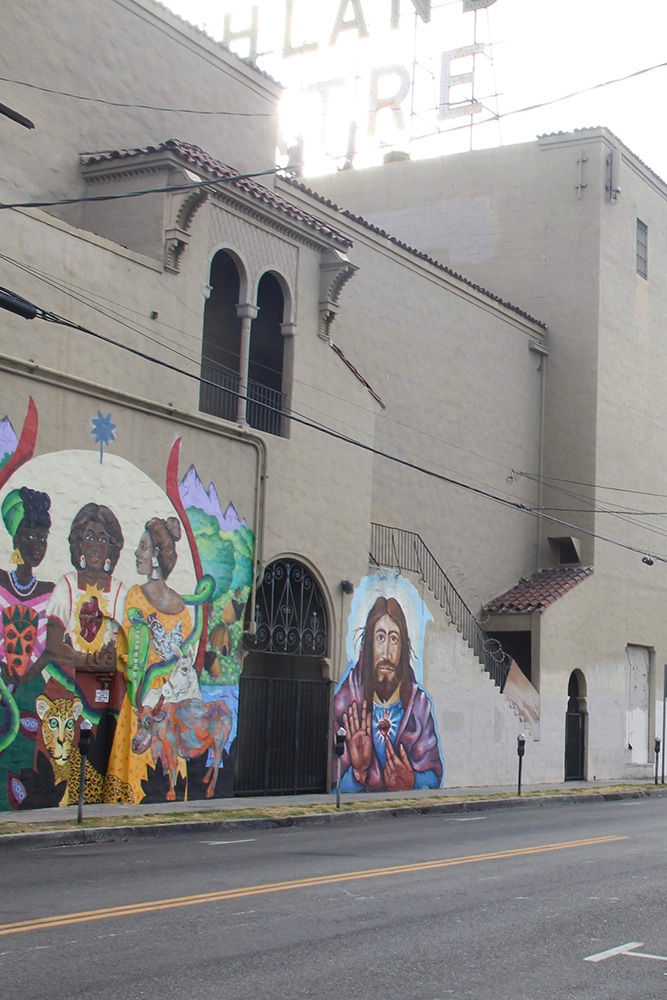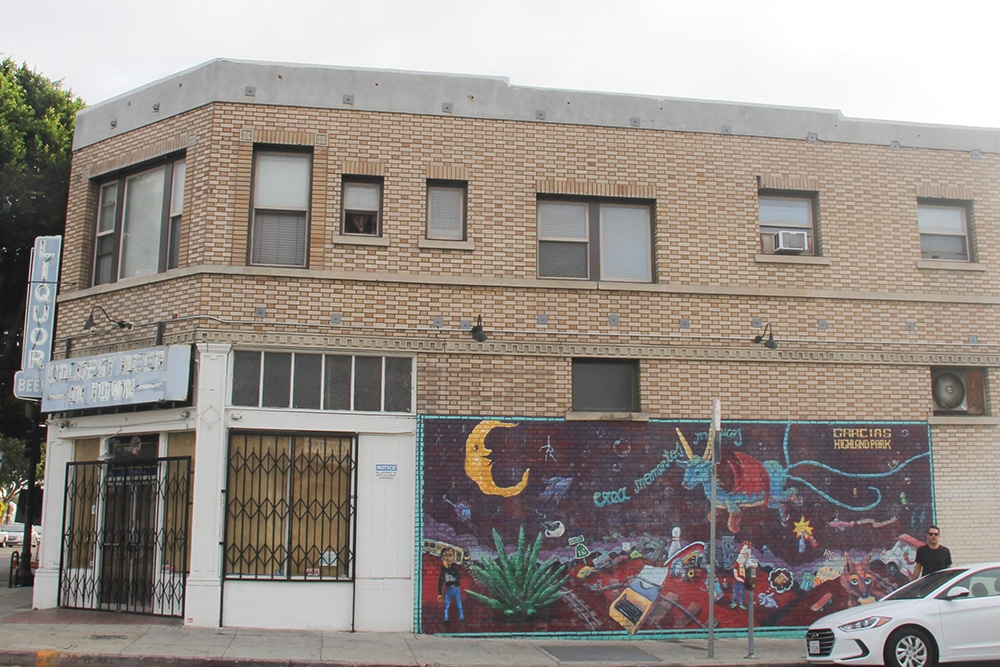
The murals in Highland Park have long been a part of the neighborhood and now have become a topic of contention, according to many community members. Local business owners, artists and activists have said that many murals have disappeared within the past few years as a result of city regulation, which has sparked backlash and efforts from the community to preserve them.
On two walls of York Valley Market, three graffiti artists who go by the names Crise, Saints and Phero* — along with others — finished painting a mural around September 2017. The mural showcased a landscape from LA to Egypt with Chicano themes including a Virgin Mary, hands uniting the Mexican and US flags and a paletero (ice cream vendor). Phero and Saints said that the tenant of the York Valley Market at the time, Miguel Moreno, gave the artists permission to paint the mural and contributed to its content. The artists decided not to officially register the mural with the LA Department of Cultural Affairs (DCA) because they did not believe it was necessary at the time, Phero said.
York Valley Market’s current tenant, Roberto Mojica, said that a representative from the city came to the property in Summer 2018 to arrange a meeting with the property owner, David Wong, to discuss graffiti on the walls. Mojica said that after these meetings, Wong and the city decided to paint over the entirety of both walls. According to Phero, the mural was erased around July 2018. Wong could not be reached for comment. The York Valley Market falls within Los Angeles City Council District 14; a representative from this district declined to comment.
According to Phero, Moreno notified him of a complaint about the mural earlier that month. The following week, Phero went back to paint over small spots that were tagged, although he said they were minor. He said he expected that these repairs would solve the problem. According to Phero, the mural was still whitewashed about a week later.
“It’s heartbreaking,” Phero said. “[The city] wants us to paint [with permission] as opposed to doing graffiti that’s illegal — which I don’t mind, but they don’t want us to do that — and they buff them. And instead, they’re replacing them with these hipster murals that don’t mean nothing to our community … So what’s my option?”
Phero said he believes murals prevent excessive tagging and gang graffiti on walls. Crise, Saints and Phero’s style is graffiti street art, and they had included lettering of their names on the mural — but nothing was gang affiliated, he said.
“[Gangs] don’t do murals and they don’t do images of the Virgin Mary and crosses,” Phero said.
In 2013, the DCA created its Mural Ordinance to promote mural preservation. If a mural is registered with the DCA, it cannot be removed for two years unless under special circumstances, and the artist must be given a 90-day notice. Under the federal Visual Artists’ Rights Act (VARA), however, owners must give that 90-day notice before removing a mural regardless of its registration status. VARA additionally provides that if a work is of “recognized stature” and has some meaning to the community, artists have the right to prevent its destruction.

The registration process involves an open community meeting and a $60 application fee. If the mural was painted before LA created the Mural Ordinance in 2013, the DCA considers it a “vintage mural;” there is no fee or community meeting required to register it. In either case, according to the DCA, the property owner — as opposed to the business owner or renter — must sign off to authorize it. Should a complaint arise, owners have the ultimate jurisdiction over what stays on their walls.
Avenue 50 Studio Director Kathy Gallegos said renters’ lack of power in these situations is an obstacle for murals’ safekeeping due to Highland Park’s rapidly changing businesses. She suggested that the city should create a temporary permit so that murals can be protected for however long the renter approving it stays. When discussing the mural on York Valley Market, Gallegos said individuals can refer to small tagging to justify the erasure of an entire mural. She claimed this often happens with murals that feature political or Chicano themes.
Applicants can approach the DCA before they paint the mural, but they can likewise apply to register a mural already in existence — even if it was painted before 2013. Because Highland Park falls into a Historic Preservation Overlay Zone (HPOZ), applicants must get permission from the Department of City Planning’s Office of Historic Resources. Highland Park also falls within Los Angeles City Council District 1, so applicants must send letters notifying the District 1 office. While applicants must also send letters notifying the Neighborhood Council and the BID, the DCA has the ultimate authority to approve or deny registrations.
Many of Highland Park’s murals are not registered, however, and have thus been vulnerable to erasure, according to Field Deputy for District 1 Bill Cody. Anyone can submit a complaint to the Department of Building and Safety (LADBS). According to Felicia Filer, the public art division director for the DCA, LADBS then contacts the DCA to ensure murals are unregistered and obtains clearance from property owners before sending a crew to whitewash the wall. DCA Public Information Director Rhonda Mitchell did not respond to questions about the York Valley Market mural.
Echoing Gallegos’ sentiments, Phero said separately his impression is that the city is more strict with murals that look “too urban” or resemble Chicano themes, but it allows other unregistered murals that do not look this way to remain, as a result of Highland Park’s gentrification and new clientele.
“That’s why a lot of people don’t jump through hoops for that,” Phero said.
Last year, a number of murals on Avenue 58’s public parking lots disappeared, according to local community members Brenda Perez, Mando Medina and Mireya Carolina Bautista Gutierrez. MichaelKohaas.org, an anti-BID blog, posted an email thread that, according to the blog, was obtained from the DCA. Members of the DCA did not respond to questions about this email thread. According to the thread, the North Figueroa Association — a nonprofit corporation that runs Highland Park’s BID and receives city funding for graffiti abatement — verified with the DCA that the murals were unregistered before painting them over. Artist John Zender Estrada, however, said one of his murals that he had registered, was erased. According to Filer, the murals were not registered.

“The parking lot was functioning as a type of freestyle graffiti yard,” Filer said via email.
With the help of community members Yaya Costillo and Mando Medina, Brenda Perez of Highland Park said she organized a vigil event Nov. 18, 2017, that honored the murals that had been erased.
“There was no due process; there was a complaint by somebody, and they just erased it. That art was there for 20, 30 years,” Medina said. “The community was pissed off because they didn’t ask us or tell us or give us warning.”
Perez referred to the erasure as “cultural homogenization,” and said there was a clear connection with gentrification and other issues in Highland Park.
“Our murals are narrative texts. They’re our history,” Perez said.
After the vigil, she founded the Restorative Justice for the Arts group and uses its Facebook page to post interviews with community members or any news related to District 1 and the murals. Her mission, she said, is to inform the community and artists of their rights. She also started a GoFundMe for John Zender Estrada to reinstall one of his murals; the fund has raised $295 of its $5,000 goal since she started six months ago. Estrada wrote in a Facebook post that he was looking to repaint his mural elsewhere, with funding from the community and not the city.
The District 1 office, which is managed by Councilmember Gil Cedillo, is involved with several of its own art projects this year, including new paintings on Highland Park’s electrical boxes and a mural by Northeast LA native and Chicano artist Frank Romero, which it installed Oct. 20. Gallegos said that among the murals erased in the Avenue 58 parking lots, she had once seen a heart painted by Romero — an icon he often paints, which is emblematic of his style. Perez and Medina also said that they have seen his works in parking lots. Romero could not be reached for comment.
According to Gallegos, District 1’s office also filed a pending request for city funding toward preserving the vintage Mexico-Tenochtitlan mural, which is located on Figueroa Street.
“This is an office that’s always supported murals,” Cody said. “[Gil Cedillo’s] track record when it comes to murals is stellar and always has been. And the office works very hard to promote murals, but if a private business who checks in with the DCA [erases one], we can’t stop them.”
Cody said he helped register two new murals after the artists had already begun painting: one on the back wall of the Highland Park establishment ETA bar, and the other on the side wall of Tinfoil, a local liquor store and deli. Both are relatively new businesses on Figueroa. For Tinfoil’s mural, local artist Sol Luongo said she wanted to incorporate both the new and old elements of the neighborhood into the landscape. The mural on ETA bar depicts a dark, fallen angel. ETA’s owners could not be reached for comment.
Medina and Perez are not satisfied with District 1 and some of the new murals.
“Now [District 1 is] trying to backpedal and say, ‘I’m gonna give you your murals back.’ It’s already done. You guys erased our murals, our history,” Medina said.
Avenue 50 Studio, in a partnership with the Athar Lina Initiative from Cairo, Egypt, finished a mural in the summer. Gallegos said they interacted heavily with the community in order to get support, which she says is different from what other new murals went through. Occidental College’s coordinator of community programs Allegra Padilla helped organize community gatherings for the project. The wall has the inscription, “In homage to the murals that’s been whitewashed.”
Highland Park Florist, which has been on Figueroa for 27 years, updated its own mural this year, keeping the Virgin Mary in the design, but adding a truck with flowers as a nod to the business. Mireya Carolina Bautista Gutierrez, a lifetime Highland Park resident and an employee of Highland Park Florist, said the artist of the original mural, Rodolfo Cardona, returned to do the repainting. The repainting was completed May 2018, according to Bautista Guitierrez, as well as the watermark on the mural itself. Cardona could not be reached for comment.
“We have no issue with the new people coming into town,” Bautista Gutierrez said. “You’re covering [the murals] up to replace them with something that’s supposed to represent us, but why not just leave what was originally there? That basically says that what we had wasn’t good enough, so ‘Let me just paint over it and fix it for you.’ … Just because you’re here doesn’t mean we have to match your standards. It doesn’t mean we weren’t good enough before.”
*The Occidental granted anonymity to these three artists and referred to them using only their artist names out of concerns for potential retaliation.
![]()


































